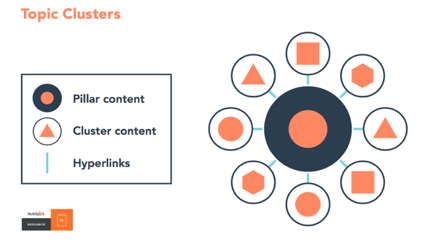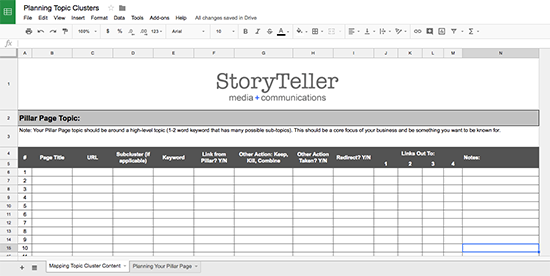What Are Content Pillars? Why Do We Need Them For SEO?
SEO is ever-changing, and trying to master it can feel like chasing your tail. You know adapting to the latest trends and search engine updates will...
6 min read
 Kathy Heil
:
Oct 26, 2017 2:06:27 PM
Kathy Heil
:
Oct 26, 2017 2:06:27 PM

Clusters and silos and pillars, oh my! No need to click your red slippers together–just sit back, relax, and we’ll help you unpack some of the most important building blocks in a successful inbound marketing strategy.
Marketers, bloggers, and SEO specialists alike must constantly adapt to the latest digital content trends and Google search ranking updates. After all, inbound marketing is an ever-evolving framework, and professionals must stay on their toes if they want to keep up with the competition. Just having a blog or a website is no longer revolutionary. Businesses must strategically craft their content and update it regularly if they want it to rank well and reach the right audience. In the early days of blogging, the conventional wisdom was to create short, concise blog posts that added value and answered questions but didn’t require a lot of time on the reader's part.
Marketers and writers alike later discovered that longer blogs were ranking higher in Google. So, of course, marketing professionals jumped on the "longer content is better content" bandwagon and began creating blogs upwards of 5,000 words.
However, as soon as bloggers swapped their short and sweet posts with long-form content, they realized that neither theory was quite fully baked. The more isn’t always the merrier–in fact, quality over quantity is still the golden rule for writers in the digital age.
With that being said, there is one form of high-quality, long-form content that every blogger and marketer needs to add to their content strategy playbook.
Enter content pillars. While this content type is nothing new, there is still a lot of mystery around what they are and how to start using them. In this post, we’re going to cover the following ideas:
Just to be clear, content pillars, content silos, and topic clusters are not new concepts.
In fact, the top definition in Google comes from a 2020 blog from Madison Marketing: “Pillar pages (also called “content pillars”) are in-depth guides that seek to comprehensively explore a topic, answer questions related to that topic, and possibly serve as a hub of links to related content.”

Source: Matt Barby
These topic-based content bundles consist of a few different parts that we’ll define so that we have a consistent set of terms to use:
This video from HubSpot does a great job of showcasing the differences between each type of content.
There are two major factors that play into why content pillars are such an important strategy for marketers to implement. First, as our digital presence (website, blogs, etc.) is ever-expanding, it will become increasingly important for us to help search algorithms know how to categorize and understand which pages belong together thematically.
Topic clusters provide a framework for creating independent sections of your website that allow search engines to crawl your content together as a whole instead of individual pieces scattered throughout your site.
Secondly, this structure allows for search algorithms to better understand which are the most relevant pages even when users' search queries don’t match the optimized keyword phrases directly.
For example, let’s say we create a page called “Understanding the Costs of a Kitchen Remodel." A person on a desktop might search for “kitchen remodel on a budget," a different user on mobile might search “kitchen remodel costs,” and a person using a voice assistant might ask, “Hey, Alexa, how much does the average kitchen remodel cost?” Under previous algorithms, you could be served three totally different results pages based on these different queries even if the page we created was the best result for all three searches.
By better structuring our pages, sites, and content to account for these differences in search mechanics, not only does it increase our rankings in Google search results, but we can also capture traffic across different devices and search queries. You're also better positioned to rank well in search engines, and algorithms evolve over time because you're creating lots of thorough, well-structured content that will meet any searcher's goals.
There are several different theories about exactly what each of these pages should look like and what should be included in them. And, truthfully, the necessary components for a successful topic cluster will mostly vary industry to industry and term to term. However, there are a few basic tenets and tactics that are universally important:
Do an Audit of Your Existing Content: Your topic clusters should include all of the blogs, articles, videos, infographics, and photos that you have on a single topic. Spend time digging through your existing content and make sure that everything fits inside of your content pillar.
Keep, Kill, Combine: As you audit through your content, don’t be afraid to combine pages and posts that have lots of overlapping information and make them into a longer, better, and higher-quality page. And if you have content that’s just bad, old, or outdated, don’t be afraid to archive it and redirect that URL to something more relevant and timely.
Focus on Quality: Ultimately, the goal is to create a cluster of content based on a single topic that is high-quality in the eyes of readers. Pages that have high bounce rates or send users off your website quickly are signals to Google that you have low-quality content on your website.
Keep it Concise: Focus on creating clusters between 6 and 30 pages (and no more).
Link Them Together: Once you’ve identified all the pages that belong together in a cluster, make sure that you have them all linking together. This signals to search engines that these pages relate to one another. Try to avoid links to content outside the cluster if at all possible.
Every company and organization will interpret the idea of topic clusters a little differently, just like every company would create a website page or landing page a little bit differently. When you are working on forming ideas, it’s important to look at other examples and start to get ideas around which layouts, content blocks, and formats would work the best for the type of content your company creates. Here are a few examples:
As search behaviors change, it’s important for marketing professionals to adapt their content creation and SEO strategies to best align with the way users want information. As consumers continue to get more and more digitally savvy, they’ll continue to favor quality content that answers all their questions in one spot.
As we look to respond to their unique needs, queries, and questions, it’s important to understand how to best frame the content in a way that meets the demands of not just the user, but also the search engines.
Topic clusters and content pillars are SEO tactics that we as marketers can’t afford to ignore.
Have more to add to the conversation? Leave a comment—we’d love to hear your thoughts.

SEO is ever-changing, and trying to master it can feel like chasing your tail. You know adapting to the latest trends and search engine updates will...

Successful lead management requires a clean database with actionable information that fits into your overall sales and marketing blueprint. That’s...

Generating new, qualified leads is crucial for sustaining and growing revenue. In the constantly changing world of digital marketing, your website...